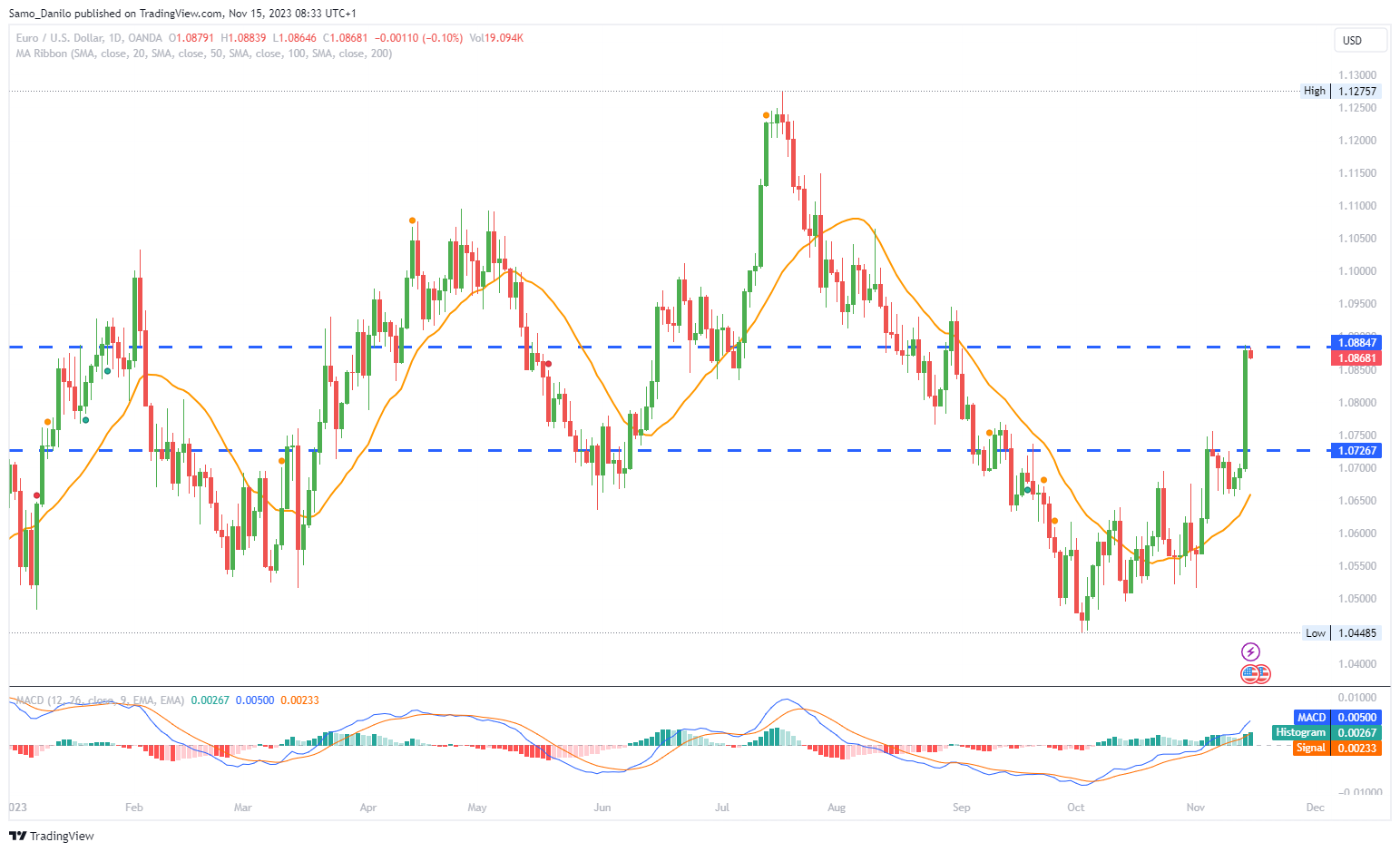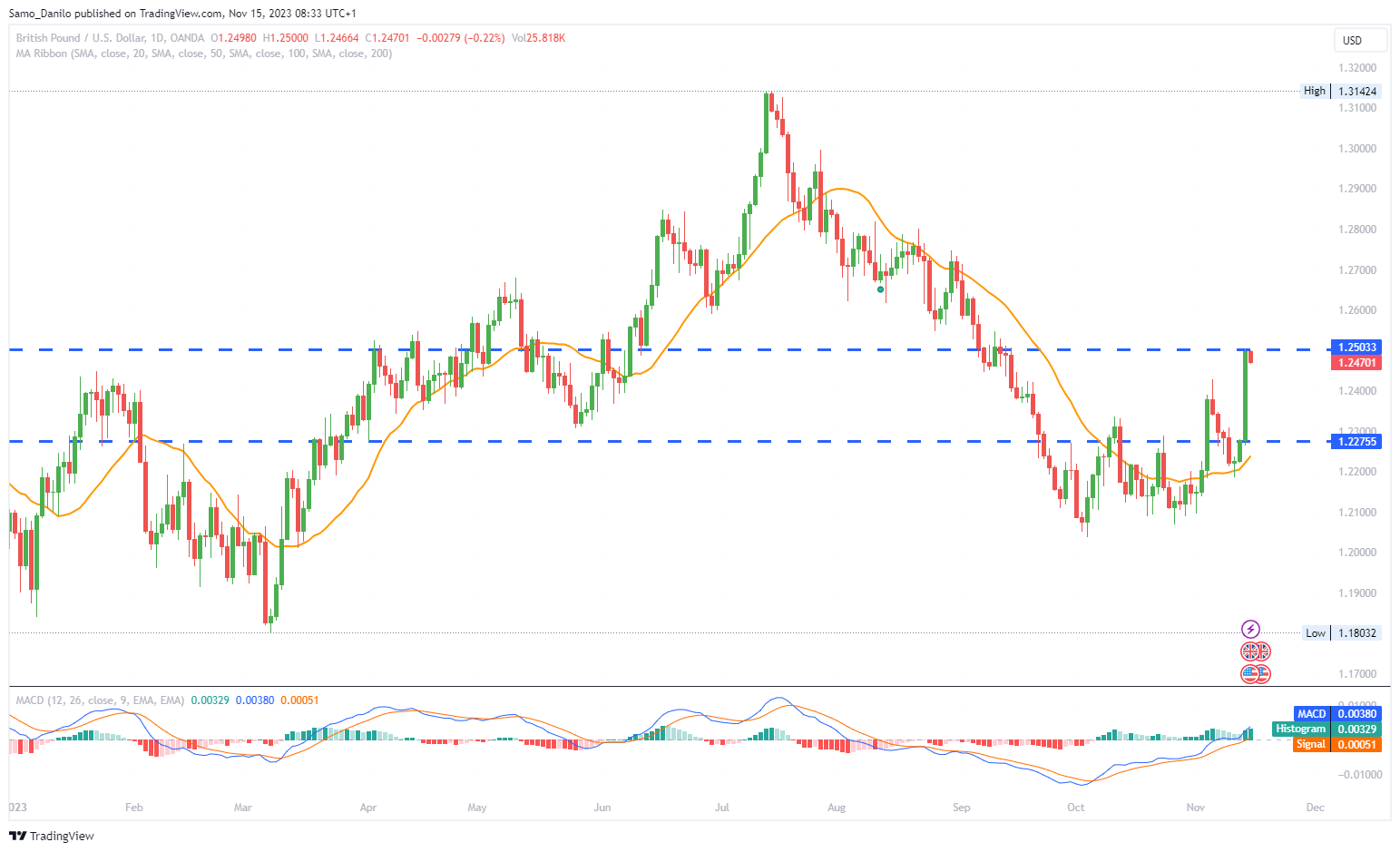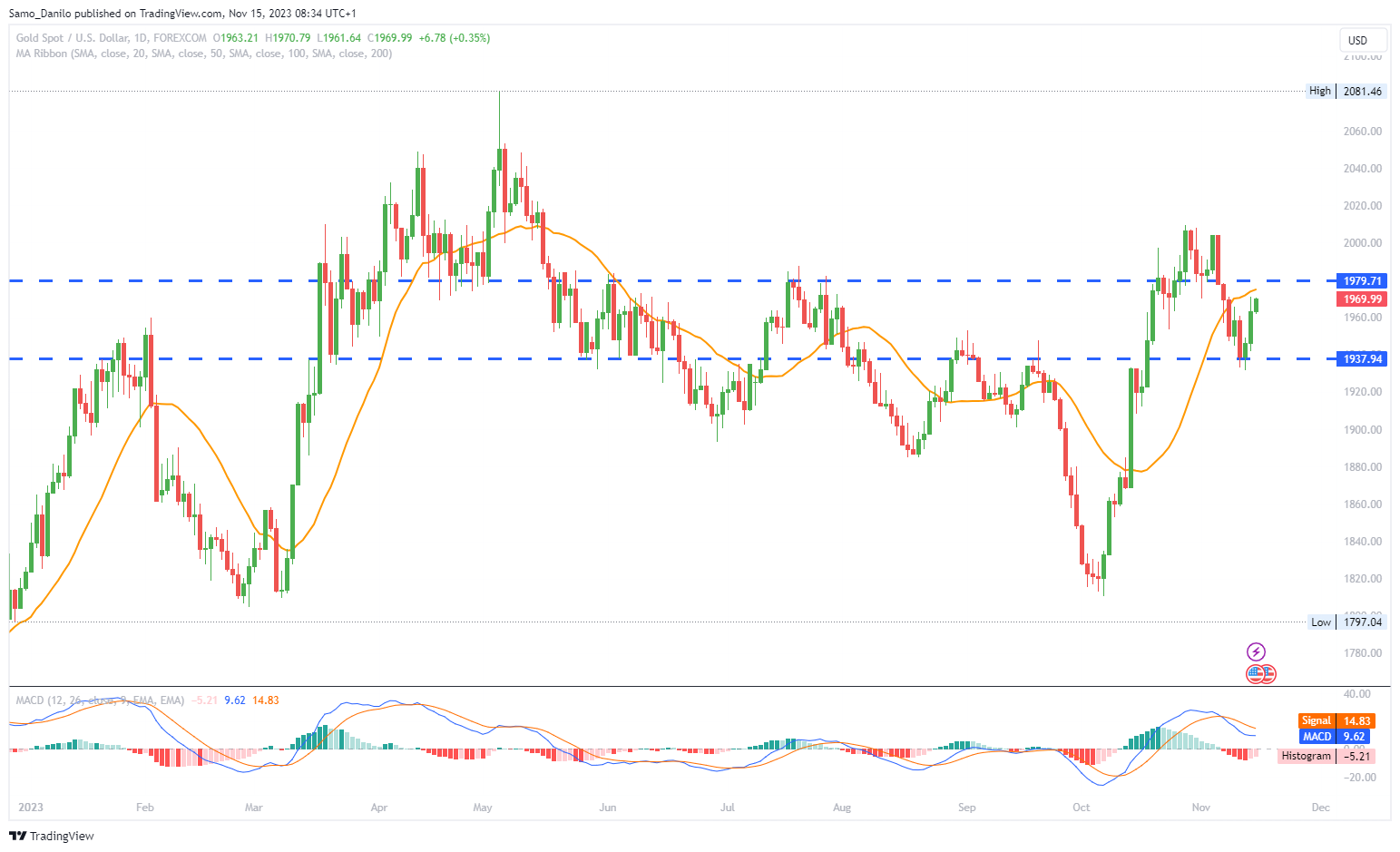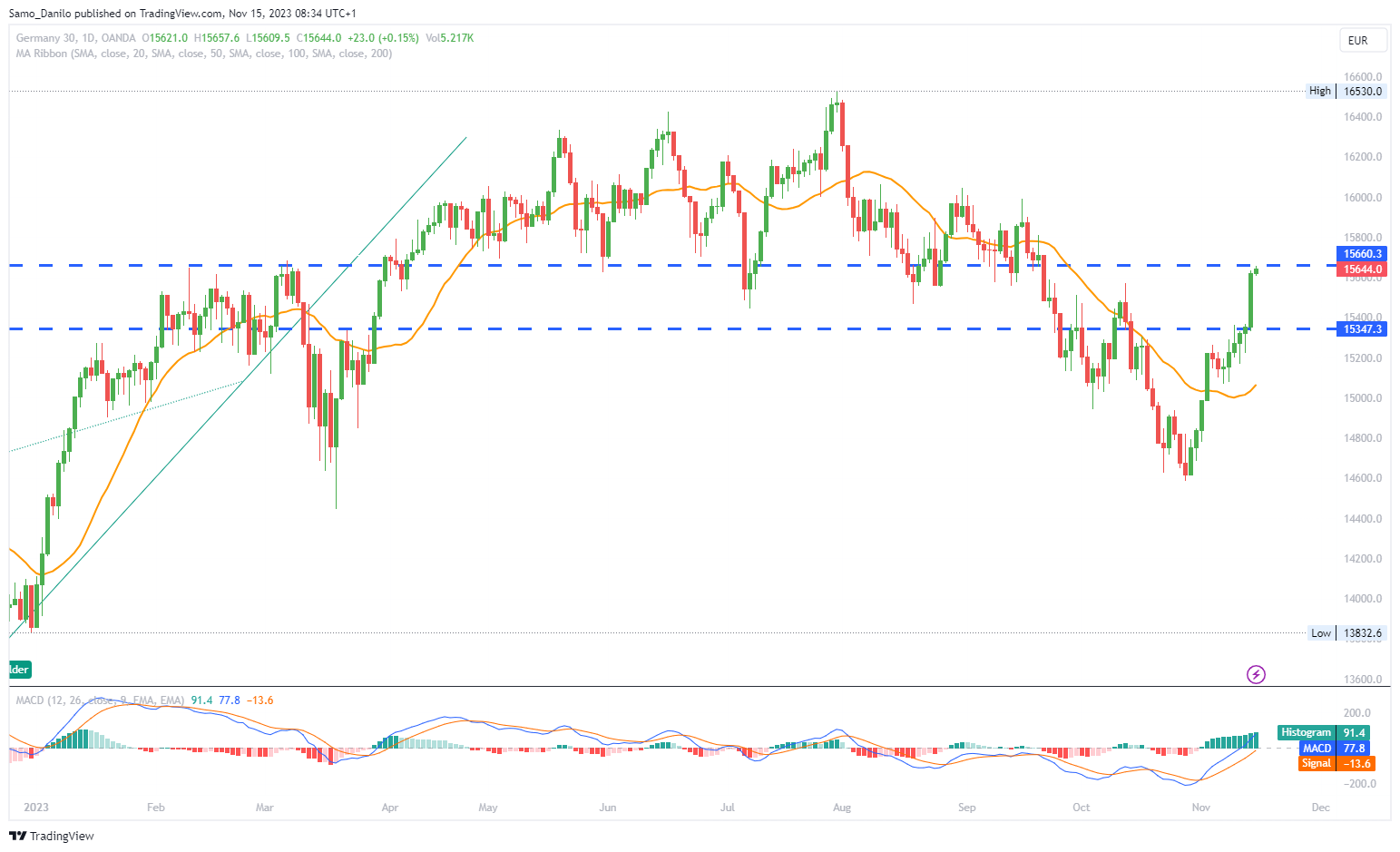EURUSD
- The EUR/USD pair surged above 1.0850 but encountered resistance below the 1.0900 mark during the early European trading hours on Wednesday.
- The significant surge of around 200 pips in EUR/USD on the previous day was attributed to a selloff in the US Dollar. This selloff was triggered by the release of US consumer inflation data.
- The US Consumer Price Index (CPI) for October remained unchanged, contrary to expectations of a 0.1% increase. The annual rate rose by 3.2%, which was below the previous month's figure of 3.7%. Core inflation also slowed more than anticipated. These data points contributed to the Dollar's decline.
- While the US economy continued to grow above trend, the Eurozone experienced a contraction of 0.1% during the third quarter. This divergence in economic performance likely influenced currency movements.
- Investors are anticipating more US inflation data with the release of the Producer Price Index (PPI) on Wednesday. Additionally, the October Retail Sales report is expected to provide further insights into the state of the US economy.
Closing statement: In summary, the recent surge in EUR/USD was fueled by a Dollar selloff prompted by the unexpected data from the US Consumer Price Index. The divergent economic performance between the US and the Eurozone also played a role. Investors are now closely watching upcoming US economic indicators, including the Producer Price Index and Retail Sales report, for further guidance on market direction.
GBPUSD
- GBP/USD experienced modest bearish pressure, slipping below 1.2500 in the European morning on Wednesday.
- The data from the UK revealed that the annual Consumer Price Index (CPI) inflation softened to 4.6% in October from 6.7% in September. The Core CPI, excluding volatile food and energy items, accelerated by 5.7% YoY in October, slightly below the forecasted 5.8%. The UK CPI stagnated at 0% MoM in October, missing the expected 0.1% increase, and contrasting with September's 0.5% rise.
- The release of softer-than-expected UK inflation data contributed to bearish pressure on GBP/USD. The annual CPI slowdown, along with other inflation indicators, appears to have influenced market sentiment.
- Continued signs of easing inflation in the UK, coupled with a softer consumer outlook, could keep the US Dollar vulnerable. This suggests that the narrative might shift back to US economic outperformance once uncertainties related to UK inflation ease.
| SMA (20) | Slightly Rising |
| |
| RSI (14) | Rising |
|
|
| MACD (12, 26, 9) | Rising |
|
|
Closing statement: GBP/USD faced bearish pressure following the release of UK inflation data, which showed a significant slowdown in annual CPI. The softer inflation figures, coupled with stagnant monthly CPI and a softer consumer outlook, contributed to the decline in GBP/USD. Traders are now attentive to whether the narrative will shift back to US economic outperformance in the broader context of currency dynamics.
GOLD
- Spot Gold experienced a surge, climbing from $1,945 to $1,970, reaching its highest level in six days. This surge was attributed to a sharp decline in the US Dollar and a rally in Treasury bonds.
- The release of US inflation data triggered a strong market reaction, leading to a decline in the US Dollar and a rally in Treasury bonds. The US Consumer Price Index showed a decrease in the annual inflation rate from 3.7% in September to 3.2% in October, falling below market estimates of 3.3%.
- The data diminished expectations of a rate hike by the Federal Reserve before the end of the year. Furthermore, it accelerated the market's anticipation of the first rate cut, shifting it from July 2024 to June.
- More US inflation data, including the Producer Price Index (PPI) and Retail Sales data, is scheduled for release on Wednesday. If these reports show slowing inflation and softer consumer data, the rally in Gold could potentially continue. The rationale is that markets would reinforce their expectations that the Federal Reserve has concluded its tightening cycle.
| SMA (20) | Rising |
|
|
| RSI (14) | Slightly Rising |
| |
| MACD (12, 26, 9) | Slightly Falling |
|
Closing statement:Gold's recent surge was influenced by a combination of factors, including the decline in the US Dollar and the rally in Treasury bonds, triggered by softer-than-expected US inflation data. The market's expectations regarding the Federal Reserve's policy stance, especially the anticipation of a rate cut, played a significant role in shaping the movement of gold prices. Traders are now closely watching upcoming US inflation data for further insights into the gold market.
CRUDE OIL
- WTI Crude Oil prices attracted dip-buying near the $77.60 region during the Asian session on Wednesday. This action temporarily halted the overnight pullback from a one-week high.
- The International Energy Agency (IEA) joined OPEC in raising its Oil demand growth forecast for 2023. This positive outlook on future demand could contribute to supporting Oil prices.
- Saudi Arabia and Russia recently announced the extension of extra voluntary cuts until the end of December. Such decisions by major oil-producing nations can influence supply dynamics and impact Oil prices.
- Despite these positive factors, the uptick in Oil prices lacks bullish conviction. This hesitation might be attributed to signs suggesting that tensions in the Middle East could be easing, potentially reducing concerns about supply disruptions.
- Traders are looking for cues from the upcoming EIA's oil inventory report. The report, being the first in two weeks, is expected to provide meaningful impetus and could offer short-term trading opportunities around Crude Oil prices.
| SMA (20) | Falling |
|
|
| RSI (14) | Falling |
|
|
| MACD (12, 26, 9) | Falling |
|
|
Closing statement:WTI Crude Oil experienced dip-buying, supported by positive outlooks from both the IEA and OPEC regarding future demand. The decision by Saudi Arabia and Russia to extend voluntary cuts added to the positive sentiment. However, there is a lack of strong bullish conviction, possibly due to easing tensions in the Middle East. Traders are closely awaiting the EIA's oil inventory report for more concrete insights into the short-term direction of Crude Oil prices.
DAX
- Better-than-expected ZEW Economic Sentiment figures for Germany and the Eurozone had a positive impact. This countered the Q3 GDP numbers and raised hopes of a short-lived recession, contributing to an improved sentiment toward the economies.
- The US Consumer Price Index (CPI) Report for October had a significant impact on the DAX. It fueled demand for riskier assets, leading to a surge in the DAX to a session high of 15,688 before experiencing a slight pullback.
- On Wednesday, the Eurozone economy will be in focus again. Eurozone trade data and industrial production figures for September are expected to garner investor interest. These data points can provide insights into the economic health of the Eurozone.
- Later in the Wednesday session, US retail sales and producer prices will be released. These reports will offer a snapshot of the demand environment in the US. Producer prices, in particular, will be crucial as they can influence consumer price trends.
- Following the US CPI Report, the input emphasizes the need to consider producer prices. A weaker demand environment might compel producers to reduce prices to remain competitive, and such adjustments can have implications for consumer prices.
| SMA (20) | Slightly Rising |
| |
| RSI (14) | Slightly Rising |
| |
| MACD (12, 26, 9) | Rising |
|
|
Closing statement: In summary, positive ZEW Economic Sentiment figures, coupled with the impact of the US CPI Report, led to a surge in the DAX. The focus now turns to upcoming Eurozone economic data and key indicators from the US, such as retail sales and producer prices. These data points will be closely watched for further insights into the economic conditions influencing the DAX.




